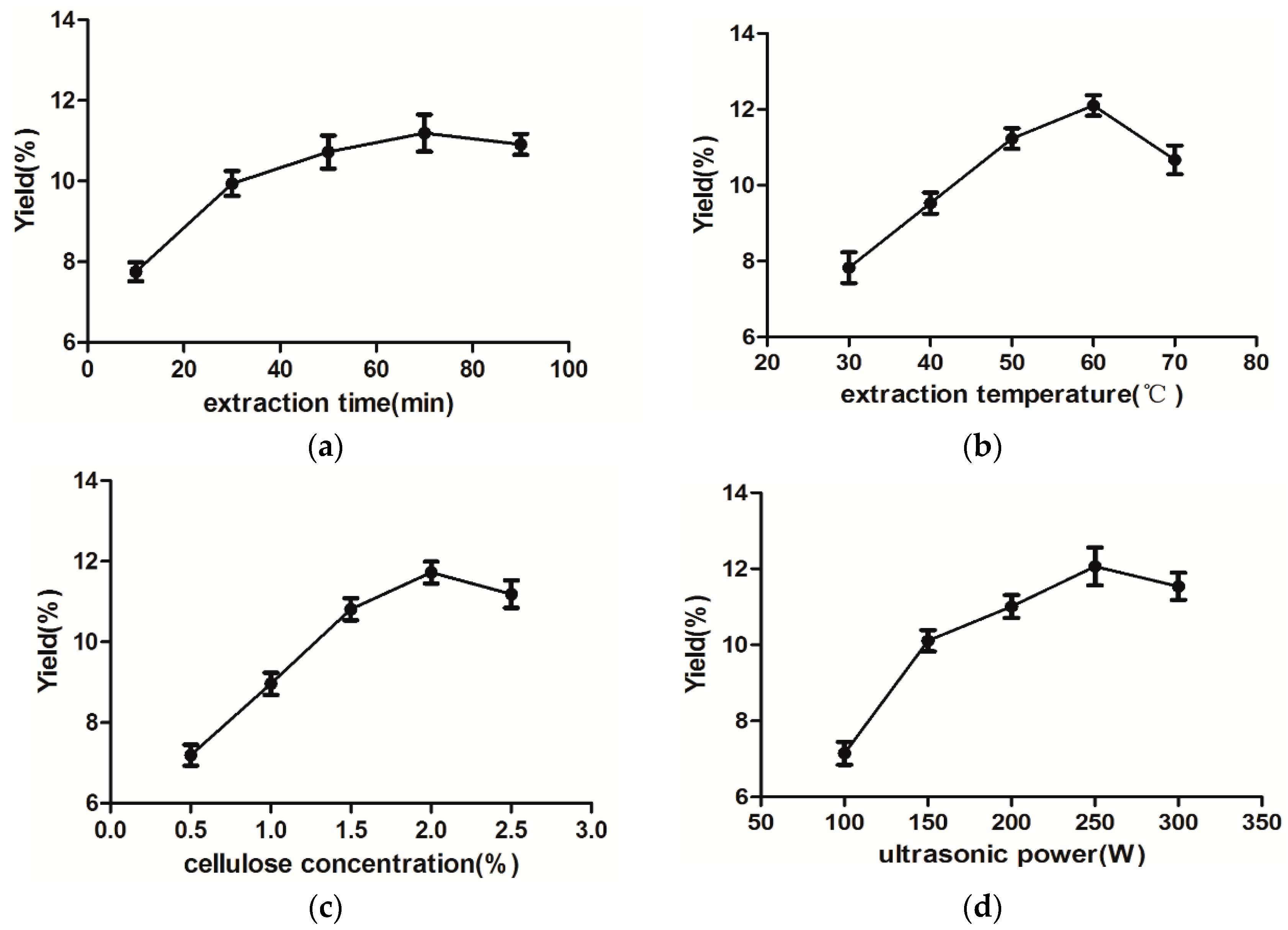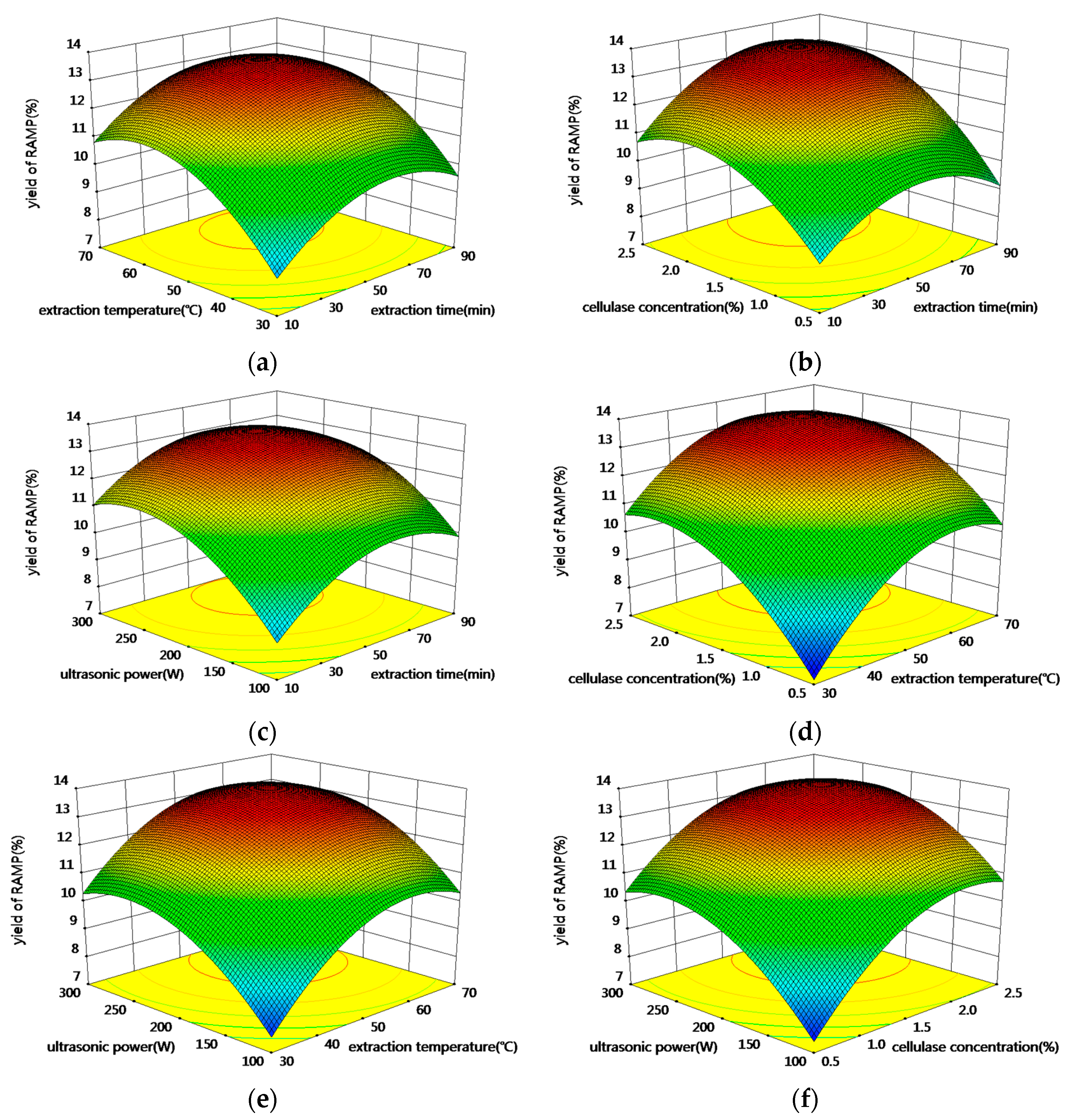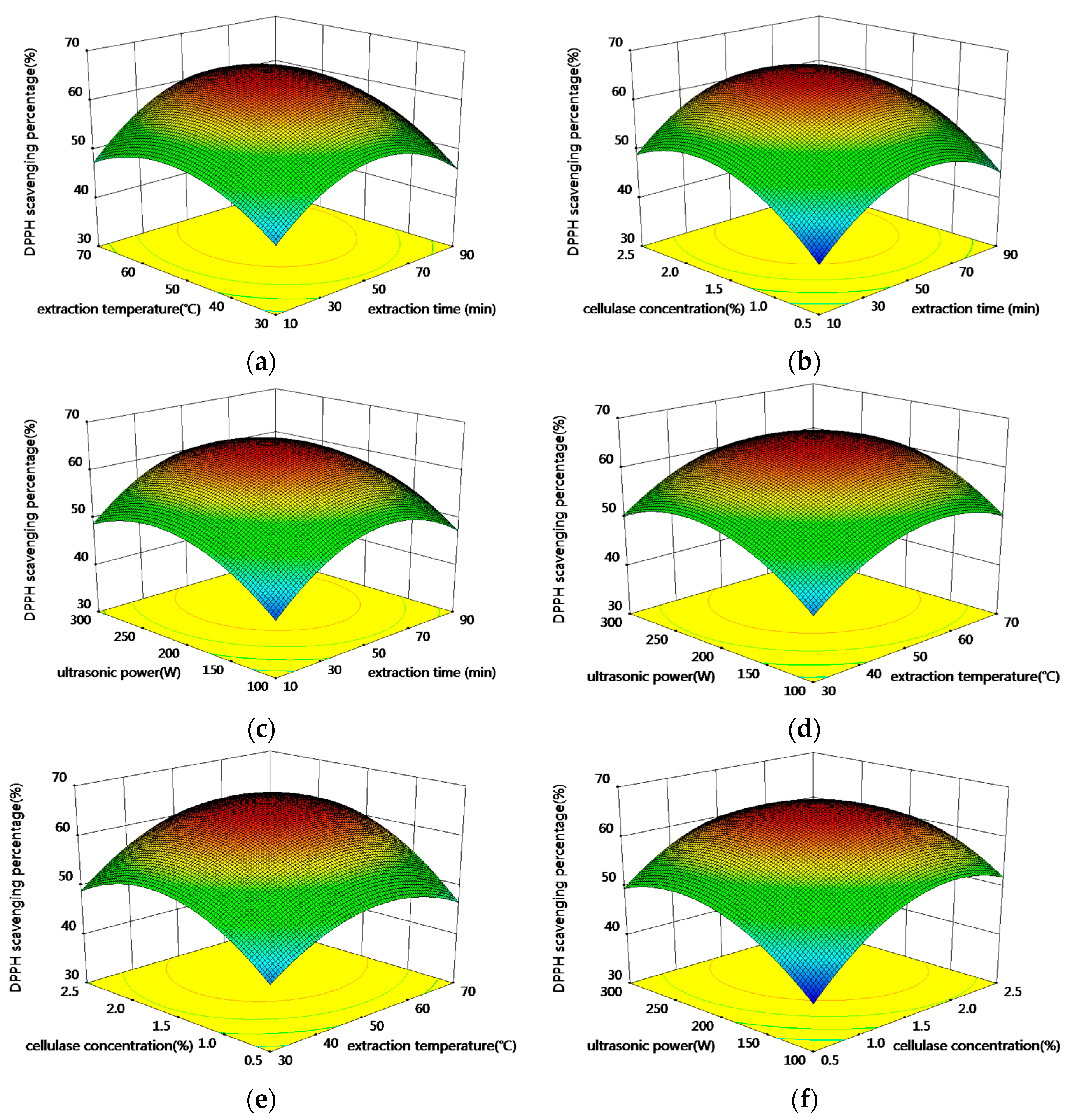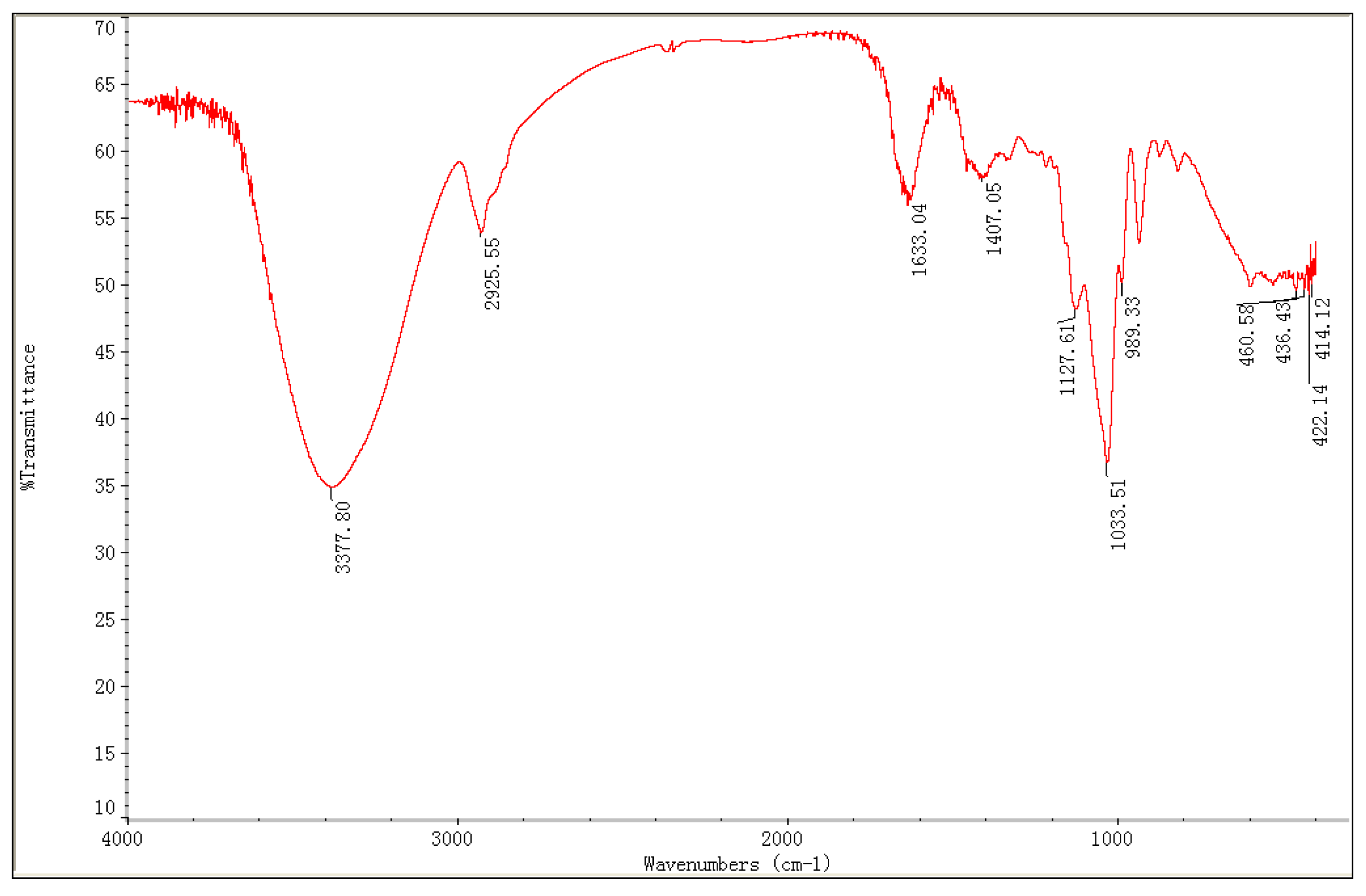Multi-Optimization of Ultrasonic-Assisted Enzymatic Extraction of Atratylodes macrocephala Polysaccharides and Antioxidants Using Response Surface Methodology and Desirability Function Approach
Abstract
:1. Introduction
2. Results and Discussion
2.1. Single Factor Experimental Analysis of UAEE
2.1.1. Effect of Extraction Time on the Yield of RAMP

2.1.2. Effect of Extraction Temperature on the Yield of RAMP
2.1.3. Effect of Cellulase Concentration on the Yield of RAMP
2.1.4. Effect of Ultrasonic Power on the Yield of RAMP
2.2. Multi-Response Design and Analysis
2.2.1. Statistical Analysis and Model Fitting
The yield of RAMP in the BBD experiments
| Run | X1 | X2 | X3 | X4 | Y1 a (%) | Y2 a (%) | D Value |
|---|---|---|---|---|---|---|---|
| 1 | 10 | 50 | 0.5 | 200 | 8.60 ± 0.63 | 39.11 ± 3.07 | 0.167 |
| 2 | 50 | 70 | 1.5 | 100 | 10.37 ± 0.52 | 50.51 ± 2.42 | 0.243 |
| 3 | 50 | 50 | 1.5 | 200 | 12.98 ± 0.64 | 63.13 ± 2.56 | 0.337 |
| 4 | 50 | 50 | 1.5 | 200 | 12.93 ± 0.65 | 63.26 ± 3.16 | 0.336 |
| 5 | 90 | 50 | 1.5 | 300 | 12.18 ± 0.62 | 54.16 ± 3.79 | 0.287 |
| 6 | 50 | 50 | 1.5 | 200 | 13.10 ± 0.59 | 63.87 ± 3.27 | 0.342 |
| 7 | 50 | 70 | 1.5 | 300 | 12.54 ± 0.60 | 57.74 ± 2.46 | 0.308 |
| 8 | 50 | 70 | 0.5 | 200 | 10.37 ± 0.57 | 46.60 ± 2.03 | 0.227 |
| 9 | 10 | 50 | 1.5 | 300 | 11.12 ± 0.70 | 48.70 ± 1.94 | 0.247 |
| 10 | 90 | 70 | 1.5 | 200 | 12.15 ± 0.50 | 56.10 ± 2.58 | 0.295 |
| 11 | 10 | 70 | 1.5 | 200 | 10.96 ± 0.56 | 48.23 ± 2.95 | 0.243 |
| 12 | 90 | 30 | 1.5 | 200 | 9.62 ± 0.71 | 46.13 ± 2.69 | 0.213 |
| 13 | 50 | 30 | 1.5 | 300 | 10.35 ± 0.63 | 51.13 ± 2.71 | 0.245 |
| 14 | 50 | 30 | 1.5 | 100 | 7.54 ± 0.55 | 42.29 ± 2.10 | 0.162 |
| 15 | 50 | 50 | 1.5 | 200 | 12.99 ± 0.72 | 63.88 ± 2.08 | 0.340 |
| 16 | 50 | 50 | 1.5 | 200 | 13.06 ± 0.70 | 63.51 ± 2.04 | 0.339 |
| 17 | 10 | 50 | 2.5 | 200 | 10.84 ± 0.59 | 49.07 ± 3.00 | 0.244 |
| 18 | 10 | 50 | 1.5 | 100 | 8.21 ± 0.74 | 41.75 ± 2.99 | 0.172 |
| 19 | 50 | 30 | 2.5 | 200 | 10.67 ± 0.58 | 49.64 ± 3.20 | 0.244 |
| 20 | 50 | 50 | 2.5 | 300 | 12.75 ± 0.50 | 55.66 ± 2.71 | 0.302 |
| 21 | 90 | 50 | 2.5 | 200 | 12.91 ± 0.72 | 55.63 ± 3.89 | 0.305 |
| 22 | 50 | 30 | 0.5 | 200 | 7.22 ± 0.53 | 42.47 ± 3.26 | 0.157 |
| 23 | 50 | 50 | 0.5 | 100 | 7.45 ± 0.50 | 39.72 ± 2.23 | 0.151 |
| 24 | 50 | 50 | 2.5 | 100 | 10.83 ± 0.51 | 51.88 ± 2.91 | 0.256 |
| 25 | 90 | 50 | 1.5 | 100 | 9.95 ± 0.70 | 48.11 ± 2.58 | 0.226 |
| 26 | 50 | 50 | 0.5 | 300 | 10.43 ± 0.45 | 50.52 ± 3.23 | 0.244 |
| 27 | 90 | 50 | 0.5 | 200 | 9.11 ± 0.67 | 45.91 ± 3.40 | 0.203 |
| 28 | 50 | 70 | 2.5 | 200 | 12.51 ± 0.50 | 59.84 ± 2.66 | 0.316 |
| 29 | 10 | 30 | 1.5 | 200 | 8.29 ± 0.80 | 43.83 ± 2.65 | 0.181 |
| Source | Sum of Squares | df | Mean Square | F | Sig. (Prob > F) |
|---|---|---|---|---|---|
| Corrected model | 100.64 | 14 | 7.19 | 1337.56 | <0.0001 |
| X1 | 5.20 | 1 | 5.20 | 967.75 | <0.0001 |
| X2 | 19.28 | 1 | 19.28 | 3587.29 | <0.0001 |
| X3 | 25.03 | 1 | 25.03 | 4656.98 | <0.0001 |
| X4 | 18.80 | 1 | 18.80 | 3498.22 | <0.0001 |
| X1X2 | <0.0001 | 1 | <0.0001 | 0.91 | 0.3558 |
| X1X3 | 0.61 | 1 | 0.61 | 113.21 | <0.0001 |
| X1X4 | 0.12 | 1 | 0.12 | 21.51 | 0.0004 |
| X2X3 | 0.43 | 1 | 0.43 | 79.83 | <0.0001 |
| X2X4 | 0.10 | 1 | 0.10 | 19.05 | 0.0006 |
| X3X4 | 0.28 | 1 | 0.28 | 52.27 | <0.0001 |
| X12 | 11.03 | 1 | 11.03 | 2052.10 | <0.0001 |
| X22 | 14.07 | 1 | 14.07 | 2617.62 | <0.0001 |
| X32 | 11.56 | 1 | 11.56 | 2151.64 | <0.0001 |
| X42 | 11.50 | 1 | 11.50 | 2139.57 | <0.0001 |
| Residual | 0.075 | 14 | <0.0001 | ||
| Lack of fit | 0.057 | 10 | <0.0001 | 1.25 | 0.4493 |
| Pure error | 0.018 | 4 | <0.0001 | ||
| Cor total | 100.71 | 28 | |||
| R2 | 0.9993 | SD | 0.60 | ||
| R2adj | 0.9985 | C.V.% | 0.68 | ||
| Adeq precision | 110.900 |

The DPPH Scavenging Percentage of RAMP in the BBD Experiments
| Source | Sum of Squares | df | Mean Square | F | Sig. (Prob > F) |
|---|---|---|---|---|---|
| Corrected model | 1629.04 | 14 | 116.36 | 376.23 | <0.0001 |
| X1 | 104.14 | 1 | 104.14 | 336.70 | <0.0001 |
| X2 | 157.91 | 1 | 157.91 | 510.55 | <0.0001 |
| X3 | 274.47 | 1 | 274.47 | 887.43 | <0.0001 |
| X4 | 158.78 | 1 | 158.78 | 513.37 | <0.0001 |
| X1X2 | 7.76 | 1 | 7.76 | 25.08 | 0.0002 |
| X1X3 | 0.014 | 1 | 0.014 | 0.047 | 0.8323 |
| X1X4 | 0.20 | 1 | 0.20 | 0.65 | 0.4320 |
| X2X3 | 9.21 | 1 | 9.21 | 29.78 | <0.0001 |
| X2X4 | 0.65 | 1 | 0.65 | 2.10 | 0.1698 |
| X3X4 | 12.32 | 1 | 12.32 | 39.83 | <0.0001 |
| X12 | 482.07 | 1 | 482.07 | 1558.67 | <0.0001 |
| X22 | 265.55 | 1 | 265.55 | 858.60 | <0.0001 |
| X32 | 360.58 | 1 | 360.58 | 1165.86 | <0.0001 |
| X42 | 290.38 | 1 | 290.38 | 938.89 | <0.0001 |
| Residual | 4.33 | 14 | 0.31 | ||
| Lack of fit | 3.86 | 10 | 0.39 | 3.27 | 0.1321 |
| Pure error | 0.47 | 4 | 0.12 | ||
| Cor total | 1633.37 | 28 | |||
| R2 | 0.9973 | SD | 0.56 | ||
| R2adj | 0.9947 | C.V.% | 1.08 | ||
| Adeq precision | 60.809 |

2.2.2. Optimization Analysis of the UAEE Procedure
2.2.3. Verification of the Predictive Model
2.3. Comparison with Other Extraction Processes

2.4. Preliminary Characterization of RAMP

3. Experimental Section
3.1. Materials
3.2. Chemical and Apparatus
3.3. Methods
3.3.1. UAEE Procedure
3.3.2. Conventional Procedure
| Extraction Processes | Extraction Conditions | ||||
|---|---|---|---|---|---|
| A | B | C | D | E | |
| HWE1 | - | - | 90 | 58 | 7.0 |
| HWE2 | - | - | 180 | 80 | 7.0 |
| EAE | 1.95 | - | 90 | 58 | 4.6 |
| UAE | - | 225 | 90 | 58 | 4.6 |
| UAEE | 1.95 | 225 | 90 | 58 | 4.6 |
3.3.3. Determination of the Yield of RAMP
3.3.4. Determination of Antioxidant Acitivity of RAMP
3.3.5. Experimental Design
Single Factor Experimental Design
Box-Behnken Design
| Independent variables | Symbol | Level | ||
|---|---|---|---|---|
| −1 | 0 | 1 | ||
| Extraction time (min) | X1 | 10 | 50 | 90 |
| Extraction temperature (°C) | X2 | 30 | 50 | 70 |
| Cellulase concentration (%) | X3 | 0.5 | 1.5 | 2.5 |
| Ultrasonic power (W) | X4 | 100 | 200 | 300 |
3.3.6. Statistical Analysis and Optimization
3.3.7. Preliminary Characterization of RAMP
4. Conclusions
Acknowledgments
Author Contributions
Conflicts of Interest
References
- Yao, C.M.; Yang, X.W. Bioactivity-guided isolation of polyacetylenes with inhibitory activity against NO production in LPS-activated RAW264.7 macrophages from the rhizomes of Atractylodes macrocephala. J. Ethnopharmacol. 2014, 151, 791–799. [Google Scholar] [CrossRef] [PubMed]
- Chinese Pharmacopoeia Commission. Pharmacopeia of People’s Republic of China; Chemical Industry Press: Beijing, China, 2010; Volume 1, p. 95. [Google Scholar]
- Chen, Z.L. The Acetylenes from Atractylodes macrocephala. Planta Med. 1987, 53, 493–494. [Google Scholar] [CrossRef] [PubMed]
- Kitajima, J.; Kamoshita, A.; Ishikawa, T.; Takano, A.; Fukuda, T.; Isoda, S.; Ida, Y. Glycosides of Atractylodes ovata. Chem. Pharm. Bull. 2003, 51, 1106–1108. [Google Scholar] [CrossRef] [PubMed]
- Dong, H.; He, L.; Huang, M.; Dong, Y. Anti-inflammatory components isolated from Atractylodes macrocephala Koidz. Nat. Prod. Res. 2008, 22, 1418–1427. [Google Scholar] [CrossRef] [PubMed]
- Shan, G.S.; Zhang, L.X.; Zhao, Q.M.; Xiao, H.B.; Zhuo, R.J.; Xu, G.; Jiang, H.; You, X.M.; Jia, T.Z. Metabolomic study of raw and processed Atractylodes macrocephala Koidz by LC-MS. J. Pharm. Biomed Anal. 2014, 98, 74–84. [Google Scholar] [CrossRef] [PubMed]
- Liu, J.; Chen, X.; Yue, C.; Hou, R.; Chen, J.; Lu, Y.; Li, X.; Li, R.; Liu, C.; Gao, Z.; et al. Effect of selenylation modification on immune-enhancing activity of Atractylodes macrocephala polysaccharide. Int. J. Biol. Macromol. 2015, 72, 1435–1440. [Google Scholar] [CrossRef] [PubMed]
- Xie, F.; Li, Y.; Su, F.; Hu, S. Adjuvant effect of Atractylodis macrocephalae Koidz. polysaccharides on the immune response to foot-and-mouth disease vaccine. Carbohydr. Polym. 2012, 87, 1713–1719. [Google Scholar] [CrossRef]
- Xie, F.; Sakwiwatkul, K.; Zhang, C.; Wang, Y.; Zhai, L.; Hu, S. Atractylodis macrocephalae Koidz. polysaccharides enhance both serum IgG response and gut mucosal immunity. Carbohydr. Polym. 2013, 91, 68–73. [Google Scholar] [CrossRef] [PubMed]
- Shi, N.; Su, J.; Yang, Z.B.; Lv, G.Y.; Chen, S.H. Antioxidantive effect of polyasaccharides from Atractylodes macrocephalaon in d-galactose-induced aging mice. Chin. J. New Drugs. 2014, 23, 577–581. [Google Scholar]
- Hu, W.X.; Xiang, Q.; Wen, Z.; He, D.; Wu, X.M.; Hu, G.Z. Neuroprotective effect of Atractylodes macrocephala polysaccharides in vitro on neuronal apoptosis induced by hypoxia. Mol. Med. Rep. 2014, 9, 2573–2581. [Google Scholar] [PubMed]
- Shan, J.J.; Tian, G.Y. Studies on physico-chemical properties and hypoglycemic activity of complex polysaccharide AMP-B from Atractylodes macrocephala Koidz. Acta Pharm. Sinica 2003, 38, 438–441. [Google Scholar]
- Zhang, P.J.; Jin, C.; Lang, J. Effect of Atractylodes macrocephalaon polysaccharides for reducing liver ischemia/reperfusion injury in rats after orthotopic liver autotransplantation. Chin. J. Integr. Tradit. West. Med. 2010, 30, 1193–1196. [Google Scholar]
- Zhao, Z.Y.; Zhang, Q.; Li, Y.F.; Dong, L.L.; Liu, S.L. Optimization of ultrasound extraction of Alisma orientalis polysaccharides by response surface methodology and their antioxidant activities. Carbohydr. Polym. 2015, 119, 101–109. [Google Scholar] [CrossRef] [PubMed]
- Lai, J.; Wang, H.; Wang, D.; Fang, F.; Wang, F.; Wu, T. Ultrasonic extraction of antioxidants from Chinese sumac (Rhus typhina L.) fruit using response surface methodology and their characterization. Molecules 2014, 19, 9019–9032. [Google Scholar] [CrossRef] [PubMed]
- Moura, J.M.L.N.; Campbell, K.; Mahfuz, A.; Jung, S.; Glatz, C.E.; Johnson, L. Enzyme-assisted aqueous extraction of oil and protein from soybeans and cream de-emulsification. J. Am. Oil Chem. Soc. 2008, 85, 985–995. [Google Scholar] [CrossRef]
- Liu, Y.; Gong, G.; Zhang, J.; Jia, S.; Li, F.; Wang, Y.; Wu, S. Response surface optimization of ultrasound-assisted enzymatic extraction polysaccharides from Lycium barbarum. Carbohydr. Polym. 2014, 110, 278–284. [Google Scholar] [CrossRef] [PubMed]
- Wang, T.; Li, C.Q.; Zhang, H.; Li, J.W. Response surface optimized extraction of 1-deoxynojirimycin from mulberry leaves (Morus alba L.) and preparative separation with resins. Molecules 2014, 19, 7040–7056. [Google Scholar] [CrossRef] [PubMed]
- Salmasnia, A.; Baradaran kazemzadeh, R.; Mohajer Tabrizi, M. A novel approach for optimization of correlated multiple responses based on desirability function and fuzzy logics. Neurocomputing 2012, 91, 56–66. [Google Scholar] [CrossRef]
- Khuri, A.; Cornell, J. Response Surfaces: Designs and Analyses, 2nd ed.; Dekker: New York, NY, USA, 1996; Volume 12, pp. 72–75. [Google Scholar]
- He, Z.; Zhu, P.F.; Park, S.H. A robust desirability function method for multi-response surface optimization considering model uncertainty. Eur. J. Oper. Res. 2012, 221, 241–247. [Google Scholar] [CrossRef]
- Derringer, G. A Balancing Act: Optimizing a Product’s Properties; Quality Press: Perth, Australia, 1994; Volume 27, pp. 51–58. [Google Scholar]
- Derringer, G.; Suich, R. Simultaneous optimization of several response variables. J. Qual. Technol. 1980, 12, 214–219. [Google Scholar]
- Islam, M.A.; Sakkas, V.; Albanis, T.A. Application of statistical design of experiment with desirability function for the removal of organophosphorus pesticide from aqueous solution by low-cost material. J. Hazard. Mater. 2009, 170, 230–238. [Google Scholar] [CrossRef] [PubMed]
- Heidari, H.; Razmi, H. Multi-response optimization of magnetic solid phase extraction based on carbon coated Fe3O4 nanoparticles using desirability function approach for the determination of the organophosphorus pesticides in aquatic samples by HPLC-UV. Talanta 2012, 99, 13–21. [Google Scholar] [CrossRef] [PubMed]
- Jeong, I.J.; Kim, K.J. An interactive desirability function method to multiresponse optimization. Eur. J. Oper. Res. 2009, 195, 412–426. [Google Scholar] [CrossRef]
- Candioti, L.V.; de Zan, M.M.; Camara, M.S.; Goicoechea, H.C. Experimental design and multiple response optimization. Using the desirability function in analytical methods development. Talanta 2014, 124, 123–138. [Google Scholar] [CrossRef] [PubMed]
- Chen, X.P.; Tang, Q.C.; Chen, Y.; Wang, W.X.; Li, S.B. Simultaneous extraction of polysaccharides from Poria cocos by ultrasonic technique and its inhibitory activities against oxidative injury in rats with cervical cancer. Carbohydr. Polym. 2009, 79, 409–413. [Google Scholar] [CrossRef]
- Chen, F.; Sun, Y.; Zhao, G.; Liao, X.; Hu, X.; Wu, J.; Wang, Z. Optimization of ultrasound-assisted extraction of anthocyanins in red raspberries and identification of anthocyanins in extract using high-performance liquid chromatography-mass spectrometry. Ultrason. Sonochem. 2007, 14, 767–778. [Google Scholar] [CrossRef] [PubMed]
- Fu, X.Y.; Xue, C.H.; Miao, B.C.; Li, Z.J.; Gao, X.; Yang, W.G. Characterization of proteases from the digestive tract of sea cucumber (Stichopus japonicus): High alkaline protease activity. Aquaculture 2005, 246, 321–329. [Google Scholar] [CrossRef]
- Ticar, B.F.; Rohmah, Z.; Ambut, C.V.; Choi, Y.J.; Mussatto, S.I.; Choi, S.D. Enzyme-assisted extraction of anticoagulant polysaccharide from Liparis tessellates eggs. Int. J. Biol. Macromol. 2015, 74, 601–607. [Google Scholar] [CrossRef] [PubMed]
- Rhein-Knudsen, N.; Ale, M.T.; Meyer, A.S. Seaweed hydrocolloid production: An update on enzyme assisted extraction and modification technologies. Mar. Drugs 2015, 13, 3340–3359. [Google Scholar] [CrossRef] [PubMed] [Green Version]
- Tahmouzi, S. Optimization of polysaccharides from Zagros oak leaf using RSM: Antioxidant and antimicrobial activities. Carbohydr. Polym. 2014, 106, 238–246. [Google Scholar] [CrossRef] [PubMed]
- Kuo, C.H.; Chen, B.Y.; Liu, Y.C.; Chang, C.M.; Deng, T.S.; Chen, J.H.; Shieh, C.J. Optimized ultrasound-assisted extraction of phenolic compounds from Polygonum cuspidatum. Molecules 2013, 19, 67–77. [Google Scholar] [CrossRef] [PubMed] [Green Version]
- Liu, J.H.; Ren, H.L.; Guan, B.; Zheng, W.C.; Gao, F. Response surface optimization of extraction process of Atractylodes polysaccharide. Chin. Tradit. Pat. Med. 2008, 30, 667–670. [Google Scholar]
- Yi, P.; Li, N.; Wan, J.B.; Zhang, D.; Li, M.; Yan, C. Structural characterization and antioxidant activity of a heteropolysaccharide from Ganoderma capense. Carbohydr. Polym. 2015, 121, 183–189. [Google Scholar] [CrossRef] [PubMed]
- Pei, J.J.; Wang, Z.B.; Ma, H.L.; Yan, J.K. Structural features and antitumor activity of a novel polysaccharide from alkaline extract of Phellinus linteus mycelia. Carbohydr. Polym. 2015, 115, 472–477. [Google Scholar] [CrossRef] [PubMed]
- Zhao, Z.; Xu, X.; Ye, Q.; Dong, L. Ultrasound extraction optimization of Acanthopanax senticosus polysaccharides and its antioxidant activity. Int. J. Biol. Macromol. 2013, 59, 290–294. [Google Scholar] [CrossRef] [PubMed]
- Savag, M.G.; Lackman, D.B.; Smolens, J. The isolation of the components of streptococcal nucleoproteins in serologically active from. J. Biol. Chem. 1938, 124, 425–436. [Google Scholar]
- Kettlitz, B. Carbohydrate Analysis: A Practical Approach; Chaplin, M.F., Kennedy, J.E., Eds.; IRL Press: Oxford, UK, 1986; p. 3. [Google Scholar]
- Vallverdu-Queralt, A.; Regueiro, J.; Martinez-Huelamo, M.; Rinaldi Alvarenga, J.F.; Leal, L.N.; Lamuela-Raventos, R.M. A comprehensive study on the phenolic profile of widely used culinary herbs and spices: Rosemary, thyme, oregano, cinnamon, cumin and bay. Food Chem. 2014, 154, 299–307. [Google Scholar] [CrossRef] [PubMed]
- Costa, N.R.; Lourenco, J.; Pereira, Z.J. Desirability function approach: A review and performance evaluation in adverse conditions. Chemometr. Intell. Lab. 2011, 107, 234–244. [Google Scholar] [CrossRef]
- Shi, X.Y.; Li, W.W.; Yu, H.Q. Optimization of H2 photo-fermentation from benzoate by Rhodopseudomonas palustris using a desirability function approach. Int. J. Hydrog. Energy 2014, 39, 4244–4251. [Google Scholar] [CrossRef]
- Bradford, M.M. A rapid and sensitive method for the quantitation of microgram quantities of protein utilizing the principle of protein-dye binding. Anal. Biochem. 1976, 72, 248–254. [Google Scholar] [CrossRef]
- Blumenkrantz, N.; Asboe-Hansen, G. New method for quantitative determination of uronic acids. Anal. Biochem. 1973, 54, 484–489. [Google Scholar] [CrossRef]
- Sample Availability: Samples of the compounds are available from the authors.
© 2015 by the authors. Licensee MDPI, Basel, Switzerland. This article is an open access article distributed under the terms and conditions of the Creative Commons by Attribution (CC-BY) license ( http://creativecommons.org/licenses/by/4.0/).
Share and Cite
Pu, J.-B.; Xia, B.-H.; Hu, Y.-J.; Zhang, H.-J.; Chen, J.; Zhou, J.; Liang, W.-Q.; Xu, P. Multi-Optimization of Ultrasonic-Assisted Enzymatic Extraction of Atratylodes macrocephala Polysaccharides and Antioxidants Using Response Surface Methodology and Desirability Function Approach. Molecules 2015, 20, 22220-22235. https://doi.org/10.3390/molecules201219837
Pu J-B, Xia B-H, Hu Y-J, Zhang H-J, Chen J, Zhou J, Liang W-Q, Xu P. Multi-Optimization of Ultrasonic-Assisted Enzymatic Extraction of Atratylodes macrocephala Polysaccharides and Antioxidants Using Response Surface Methodology and Desirability Function Approach. Molecules. 2015; 20(12):22220-22235. https://doi.org/10.3390/molecules201219837
Chicago/Turabian StylePu, Jin-Bao, Bo-Hou Xia, Yi-Juan Hu, Hong-Jian Zhang, Jing Chen, Jie Zhou, Wei-Qing Liang, and Pan Xu. 2015. "Multi-Optimization of Ultrasonic-Assisted Enzymatic Extraction of Atratylodes macrocephala Polysaccharides and Antioxidants Using Response Surface Methodology and Desirability Function Approach" Molecules 20, no. 12: 22220-22235. https://doi.org/10.3390/molecules201219837






